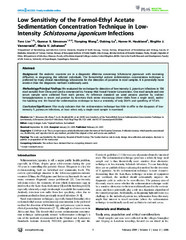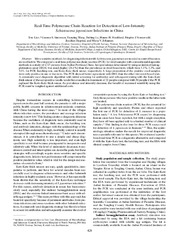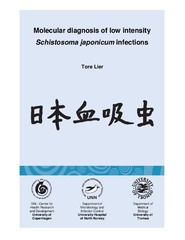| dc.contributor.advisor | Johansen, Maria Vang | |
| dc.contributor.author | Lier, Tore | |
| dc.date.accessioned | 2010-06-18T10:42:35Z | |
| dc.date.available | 2010-06-18T10:42:35Z | |
| dc.date.issued | 2010-03-08 | |
| dc.description.abstract | <i>Introduction:</i>
<br>Schistosoma japonicum is a parasitic fluke. The adult worms live as a pair in the small mesenteric blood vessels along the intestines. The eggs are excreted in the stool. It is endemic mainly in parts of China and the Philippines with the estimated prevalence in humans exceeding a million cases. Successful control programmes have run for several decades with the result that most remaining infections are of low intensity. This is a challenging diagnostic situation and has reduced the predictive values of the diagnostic tests commonly used so far. Antibody detection results in many false positive cases due to past infections and cross reactions with other infections. Kato Katz thick smear and hatching test, which both detect eggs in stool, miss a substantial number of the infected cases.
<br><i>Aim:</i>
<br>Our aim for this project was to look for an alternative diagnostic strategy. Our emphasis was on real-time PCR, since this is a method with potentially high sensitivity and specificity.
<br><i>Results:</i>
<br>The results of our investigations are presented in four papers:
<br>1. In the first paper we developed and evaluated a PCR which targets the mitochondrial NADH dehydrogenase I gene from S. japonicum. SYBR Green was used for detection. We also compared different modifications of DNA extraction methods and found two methods to be equally efficient; the non-commersial ROSE extraction and the commercial QIAamp DNA Stool Mini Kit. The PCR had high sensitivity in stool
samples artificially spiked with eggs, even in samples containing a single egg. The
PCR was specific for S. japonicum when it was tested on different Schistosoma
species and other worms commonly found in stool.
<br> 2. In Paper two we compared the PCR (using both extraction methods) with a sensitive stool microscopy test and antibody detection in an animal model using twelve pigs with a low intensity S. japonicum infection and three uninfected controls. PCR with
either extraction method were equally sensitive as microscopy. However, both the faecal PCR and microscopy results were mostly negative when faecal egg output almost reached nil in the chronic last stage of the trial, despite persistent worm burdens. In this stage the PCR gave higher proportion positive samples than microscopy. Antibody titers remained high throughout the study. PCR was consistently negative in serum and urine samples.
<br>3. In Paper three we used clinical samples from 1727 persons from Anhui province,
China, to compare PCR with tests commonly used in China. We developed a new PCR which targeted the same gene as the PCR described in Paper one and two, now using ROSE extraction and a MGB probe for detection. Detection of antibodies in serum was done by IHA. Kato-Katz thick smear microscopy, hatching test and PCR was done on the same stool sample. The prevalence was very high when IHA was used (26.1%). PCR resulted in a higher prevalence (5.3%) than hatching (3.2%) or Kato-Katz (3.0%). It was of some concern that most of the stool samples were only positive in one or two of the three stool based tests. Possible reasons for this disagreement are discussed. PCR displayed better agreement with IHA than the other two stool-based tests. A commonly used diagnostic algorithm with initial screening for antibodies and subsequent testing with Kato-Katz of the seropositive would have resulted in treatment of 22 people, compared to 50 people if PCR replaced Kato-Katz. We also showed that it is possible to do a cheap, non-commercial DNA extraction in a local laboratory with quite basic equipment and do the amplification itself in a larger laboratory.
<br>4. Formol-ethyl acetate sedimentation concentration technique (FEC) is preferred by
many clinical microbiology laboratories for the detection of parasites in stool samples, but there are no previously published results for S. japonicum. A sub-set of clinical samples from 106 Chinese persons were selected from the sample collection in Paper three. A person was considered positive by the ‘reference standard’ if antibody detection (IHA) was positive together with Kato-Katz positive and/or hatching test positive. This reference standard resulted in a disappointingly low FEC sensitivity of 28.6% and a specificity of 97.4%.
<br><i>Conclusion:</i>
<br>PCR seems to be a diagnostic alternative with high sensitivity and specificity and could have a role in a diagnostic algorithm. However, it is still an expensive alternative. | en |
| dc.description.doctoraltype | ph.d. | en |
| dc.description | Papers number 1 and 2 of the thesis are not available in Munin, due to publishers' restrictions:
<br>1. Lier T, Simonsen GS, Haaheim H, Hjelmevoll SO, Vennervald BJ, Johansen MV: «Novel real-time PCR for detection of <i>Schistosoma japonicum</i> in stool», Southeast Asian Journal of Tropical Medicine and Public Health, 2006 Mar;37(2):257-64. Available at <a href=http://www.tm.mahidol.ac.th/seameo/2006_37_2/03-3713.pdf>http://www.tm.mahidol.ac.th/seameo/2006_37_2/03-3713.pdf</a>
<br>2. Lier T, Johansen MV, Hjelmevoll SO, Vennervald BJ, Simonsen GS.: «Real-time PCR for detection of low intensity <i>Schistosoma japonicum</i> infections in a pig model», Acta Tropica, 2008 Jan;105(1):74-80 (Elsevier). Available at <a href=http://dx.doi.org/10.1016/j.actatropica.2007.10.004>http://dx.doi.org/10.1016/j.actatropica.2007.10.004</a> | en |
| dc.format.extent | 10098896 bytes | |
| dc.format.extent | 598841 bytes | |
| dc.format.extent | 141397 bytes | |
| dc.format.mimetype | application/pdf | |
| dc.format.mimetype | application/pdf | |
| dc.format.mimetype | application/pdf | |
| dc.identifier.isbn | 978-82-7589-253-7 | |
| dc.identifier.uri | https://hdl.handle.net/10037/2499 | |
| dc.identifier.urn | URN:NBN:no-uit_munin_2246 | |
| dc.language.iso | eng | en |
| dc.publisher | Universitetet i Tromsø | en |
| dc.publisher | University of Tromsø | en |
| dc.rights.accessRights | openAccess | |
| dc.rights.holder | Copyright 2010 The Author(s) | |
| dc.rights.uri | https://creativecommons.org/licenses/by-nc-sa/3.0 | en_US |
| dc.rights | Attribution-NonCommercial-ShareAlike 3.0 Unported (CC BY-NC-SA 3.0) | en_US |
| dc.subject | VDP::Medisinske fag: 700::Basale medisinske, odontologiske og veterinærmedisinske fag: 710::Medisinsk molekylærbiologi: 711 | en |
| dc.subject | VDP::Medisinske fag: 700::Basale medisinske, odontologiske og veterinærmedisinske fag: 710::Medisinsk mikrobiologi: 715 | en |
| dc.subject | VDP::Medisinske fag: 700::Klinisk medisinske fag: 750::Tropemedisin: 761 | en |
| dc.subject | VDP::Medical disciplines: 700::Basic medical, dental and veterinary science disciplines: 710::Medical molecular biology: 711 | en |
| dc.subject | VDP::Medical disciplines: 700::Basic medical, dental and veterinary science disciplines: 710::Medical microbiology: 715 | en |
| dc.subject | VDP::Medical disciplines: 700::Clinical medical disciplines: 750::Tropical medicine: 761 | en |
| dc.title | Molecular diagnosis of low intensity
Schistosoma japonicum infections | en |
| dc.type | Doctoral thesis | en |
| dc.type | Doktorgradsavhandling | en |


 English
English norsk
norsk





